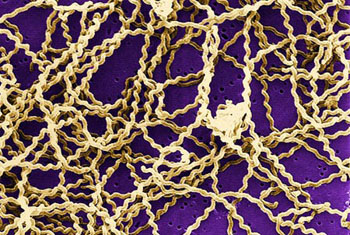Asymptomatic Individuals May Shed Infective Leptospira Bacteria in Their Urine
By LabMedica International staff writers
Posted on 09 Mar 2016
An international team of molecular microbiologists has assembled a comprehensive, cross-species genomic comparison of all 20 known species of Leptospira and determined that a pool of asymptomatic individuals was shedding the bacteria in their urine. Posted on 09 Mar 2016
The more than 200 types of spiral-shaped bacteria (spirochetes) in the genus Leptospira are classified as pathogenic, intermediately pathogenic, or saprophytic based on their ability to cause disease and on genetic information.

Image: Scanning electron micrograph of Leptospira sp. Bacteria (Photo courtesy of the CDC - US Centers for Disease Control and Prevention).
In humans, approximately 90% of cases of the disease are mild leptospirosis. Others experience a severe form of the disease known as Weil's disease, which is characterized by liver damage (causing jaundice), kidney failure, and bleeding. Additionally, the heart and brain can be affected; meningitis of the outer layer of the brain, encephalitis of brain tissue with same signs and symptoms; and lung affected as the most serious and life-threatening of all leptospirosis complications. The infection is often incorrectly diagnosed due to the nonspecific symptoms.
An international team of molecular microbiologists sought evidence for human reservoirs of the bacteria and for genetic clues as to why it caused such a broad range of symptoms among infected individuals. The investigators from the United States, Australia, France, England, The Netherlands, Canada, Uruguay, Brazil, Peru, and Thailand used a combination of epidemiological data, serology, and molecular detection of the leptospiral 16S rRNA gene to identify asymptomatic urinary shedders of Leptospira among the inhabitants of a rural village in the Peruvian Amazon region.
They reported in the February 23, 2016, online edition of the journal PLOS Neglected Tropical Diseases that approximately one-third of 314 asymptomatic participants had circulating anti-leptospiral antibodies. Among enrolled participants, 189 (59%) had evidence of recent infection. Among these people, 13 (all women) had Leptospira DNA-positive urine samples. A group of 102 long-term asymptomatic individuals without serological evidence of recent infection was identified. Within this group, six (5.9%) excreted pathogenic and intermediate-pathogenic Leptospira in their urine.
The results showed that asymptomatic renal colonization of Leptospira bacteria in a region of high disease transmission was common, including among people without serological or clinical evidence of recent infection. Both pathogenic and intermediate Leptospira could persist as renal colonization in humans.
“Leptospira is the most complex genus of bacteria that infects humans,” said senior author Dr. Joseph M. Vinetz, professor of medicine at the University of California, San Diego (USA). “This work compares the complete genome sequences of all known species of Leptospira to discover which genes make this bacterium a pathogen. It provides a roadmap for future research, including finding new ways to diagnose infection and vaccine development.”
“One fascinating finding was discovering the CRISPR-Cas genetic machinery only in pathogenic Leptospira, but not in the intermediate or non-infectious groups of the genus. The evolutionary acquisition of novel CRISPR elements, which are only in pathogenic Leptospira, probably hastened adaptation to human infection. The significance of this observation remains to be explored,” said Dr. Vinetz.
Related Links:
University of California, San Diego







 assay.jpg)





